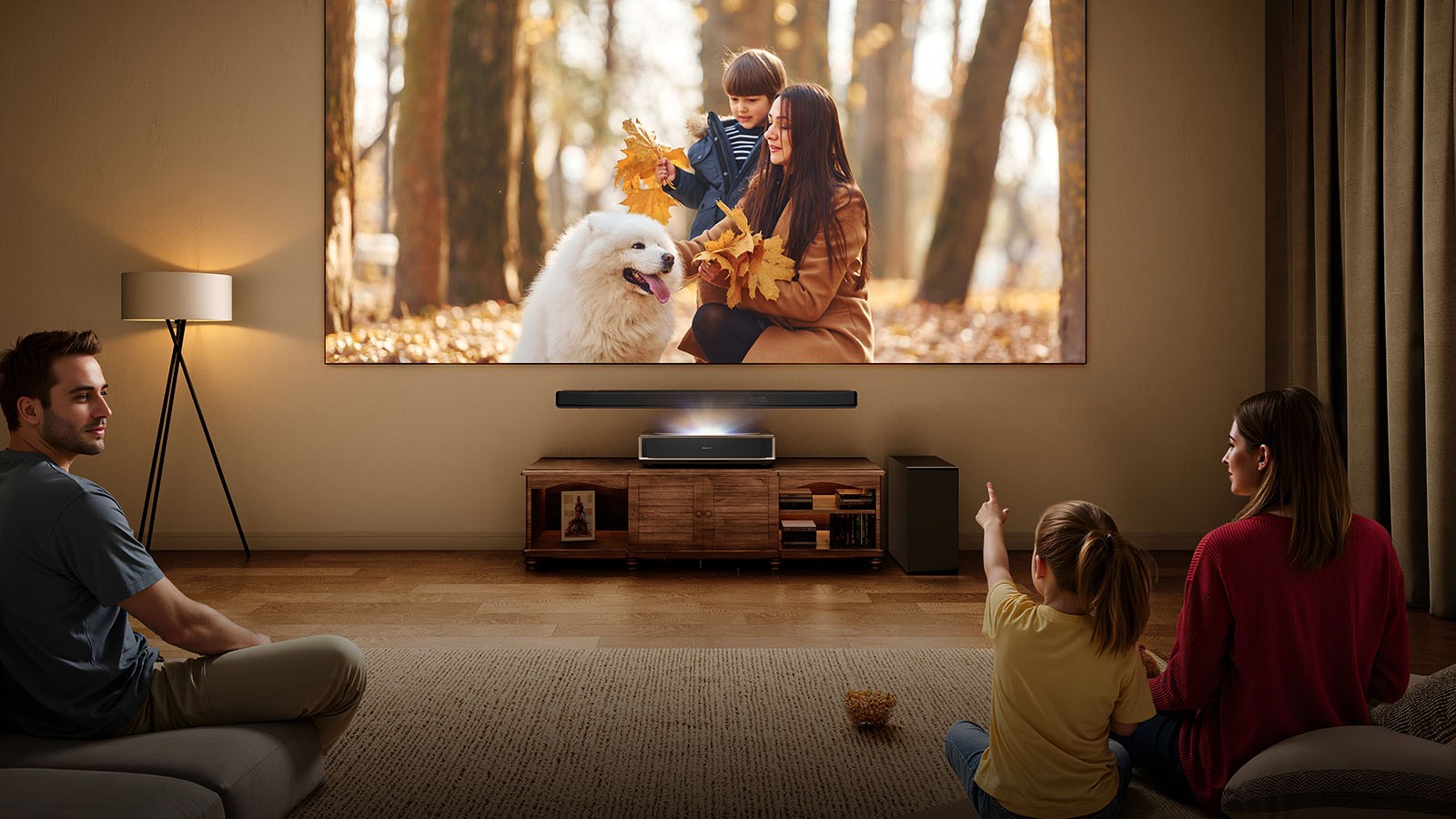As the official partner of the FIFA Club World Cup, which took place in the United States and has been a fixture on the agenda for football fans for the past four weeks, Hisense aims to be a partner for all emotions, especially those of the 7th art. On the program, a range of revamped UST (Ultra Short Throw) Laser Cinema 2025 video projectors, with the goal of a truly immersive, easy-to-install home cinema experience. The AVcesar editorial team took the opportunity (obviously) to spotlight three of the brand's products, including the new PT1 model.
In just a few years, first with its Laser TV models (equipped with a [abc]DVB-T[/abc]2/S2/C tuner to also enjoy [abc]TNT[/abc] content, satellite or cable in XXL format), and then with its mini projectors, the manufacturer Hisense has established itself as a global leader in the world of short-throw laser projectors. But the Hisense promise via its Laser Cinema 2025 models is even more beautiful: transform your living space, lounge, games room, bedroom, etc. into a Home Cinema room with minimal space requirements. And enjoy the latest films, series and games in a very large and multi-channel sound. And if Paris or Rome were not built in a day, the same is true for Hisense and video projection. To become one of the leaders in the sector, the Asian company has devoted years of research and development to the design of projection heads based on ever more efficient technologies. Its range of latest generation laser projectors, optimized for cinema but also for sports broadcasts or gaming, is the best illustration of this.
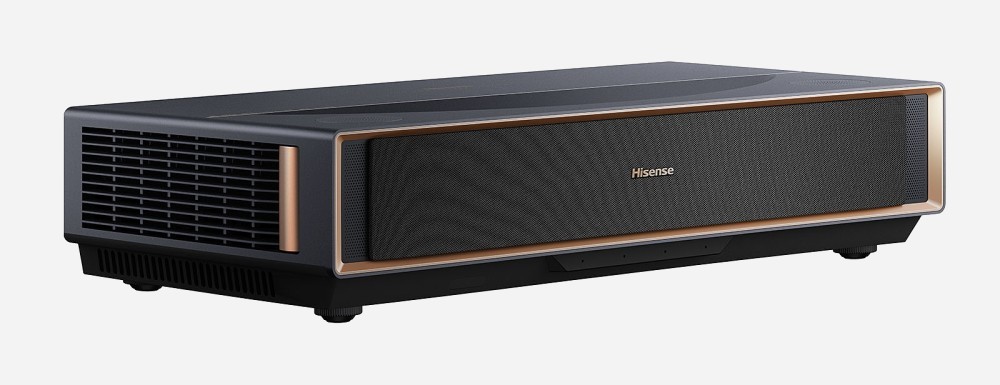
Hisense, pioneer of triple laser with TriChroma technology££££ Since the first generations of laser video projectors, image quality has continued to improve. Hisense quickly stood out by integrating cutting-edge technologies to offer images more vivid colors, increased brightness and precision in details worthy of the best equipment. This is, among other things, the case with the implementation of TriChroma technology. A major development, it has allowed Hisense to differentiate itself from the competition by offering a real leap in terms of image quality, precision and brightness. Exclusive to Hisense, it is based on three separate laser sources, one red, one green and one blue. This is rarely the case with conventional systems, which generally have a single laser source coupled with color filters (see illustration below).
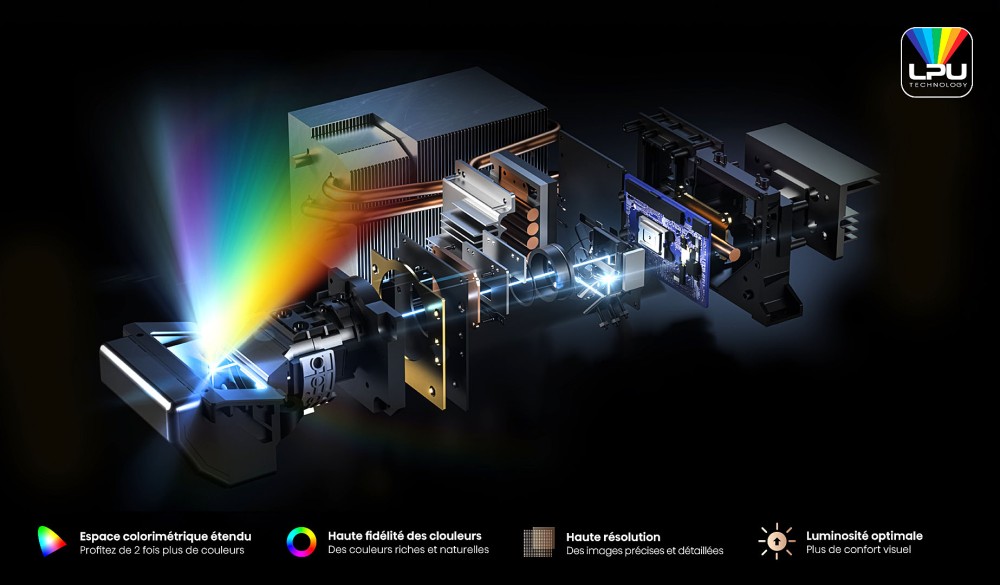
The tri-laser technology chosen by Hisense gives its projectors impressive color reproduction, covering more than 110% of the BT.2020 color space, a level that the latest TVs struggle to achieve. Blacks are deeper, details finer and contrasts enhanced, even in conditions of strong ambient light.
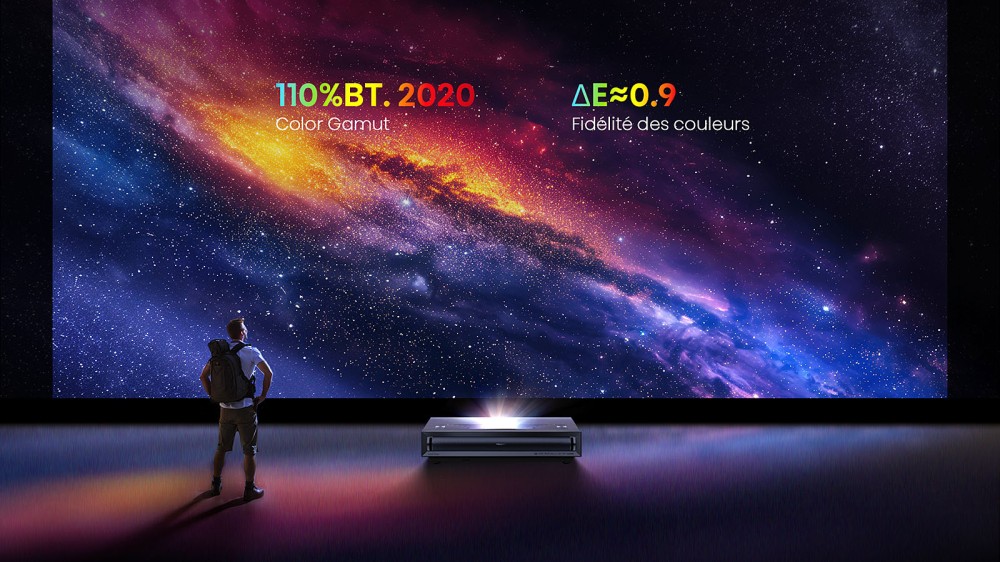
Hisense, pioneer of ultra short throw££££ Furthermore, the appearance of UST (ultra short throw) projectors has transformed their use in Home Cinema configurations. Unlike traditional projectors that must be installed several meters from the screen, Hisense UST models with their throw ratio of approximately 0.2 can be placed just a few centimeters from the wall, or the screen, while projecting an image whose diagonal can reach up to 150" (see illustration below), or more than 3.80 m diagonal.
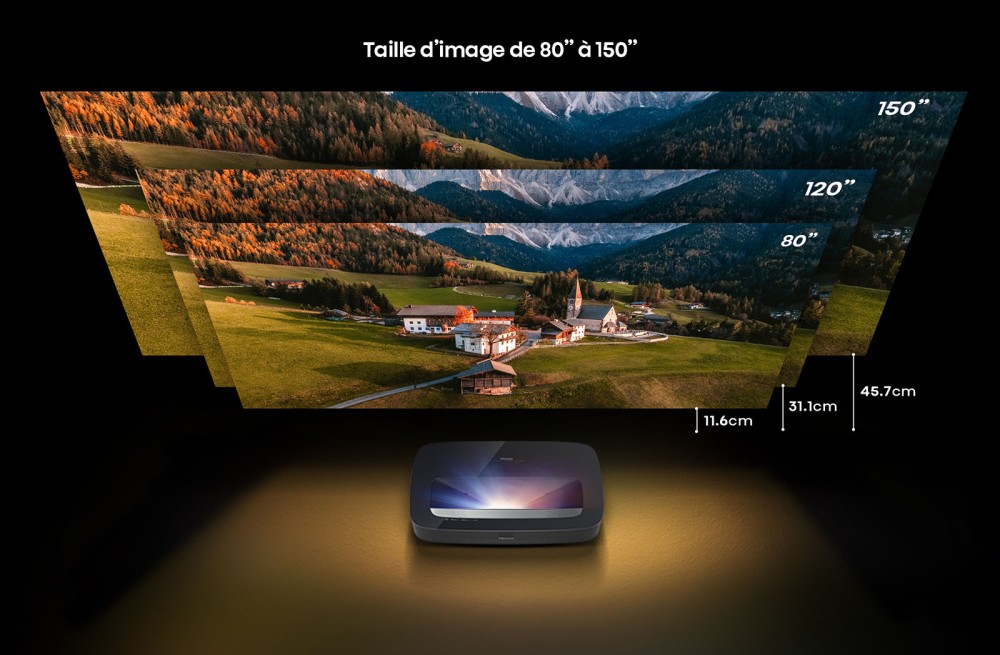
If, as with any conventional video projector, a white wall is enough to be able to project an image of impressive dimensions, to fully benefit from the optimal image quality, Hisense (and the editorial staff of AVcesar) recommends the use of a technical screen called ALR, for Ambient Light Rejection. It improves the contrast and clarity of the image, even in a bright room. It eliminates the reflection of ambient light to reflect only that coming from the video projector (see illustration below) and delivers an image quality comparable to that of a television but of a larger size gigantic.
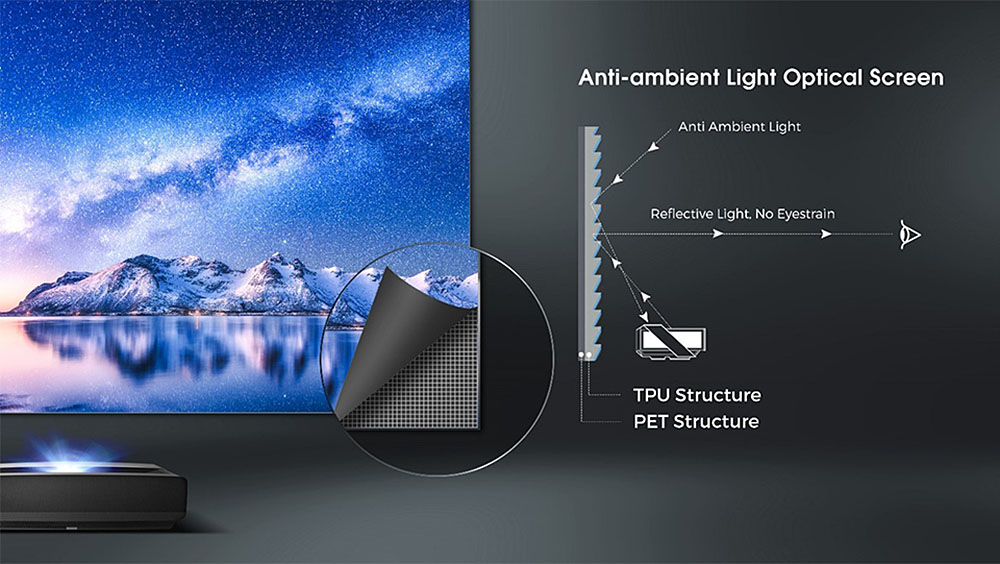
Hisense Laser Cinema, solutions for every situation££££ Finally, Hisense also aims to offer solutions that precisely meet everyone's expectations and, above all, their budget. Already in his time, that is to say around 350 years before J.-C., Aristotle proclaimed: "Progress is only worthwhile if it is shared by all." If the maxim was taken up by the SNCF in the 90s, Hisense made it its own in 2025 with a range that is based around three models, the PL2, the PX3-Pro and the PT1. • The Hisense PL2 is the [abc]Ultra HD[/abc] [abc]4K[/abc] single laser model in this family of ultra short throw video projectors. It serves as the ideal gateway to discover the world of laser projection. Compatible [abc]HDR10[/abc]/[abc]HDR10+[/abc] and [abc]HDR Dolby Vision[/abc], it is capable of exploiting the contrast dynamics offered by these standards available on 4K [abc]Ultra HD Blu-Ray[/abc] discs, [abc]SVOD[/abc] services (Netfix, Disney+, Amazon Prime, Max, Canal+…, see illustration below). In addition, it has an integrated [abc]Dolby Atmos[/abc] audio system which makes it, in the presence of the Hisense HT Saturn pack (see below), a real complete Home Cinema system (and, what's more, inexpensive). Compact and easy to install, this video projector is aimed at lovers of large image formats but who are keen to spend a reasonable budget on their equipment, less than 2,000 euros.
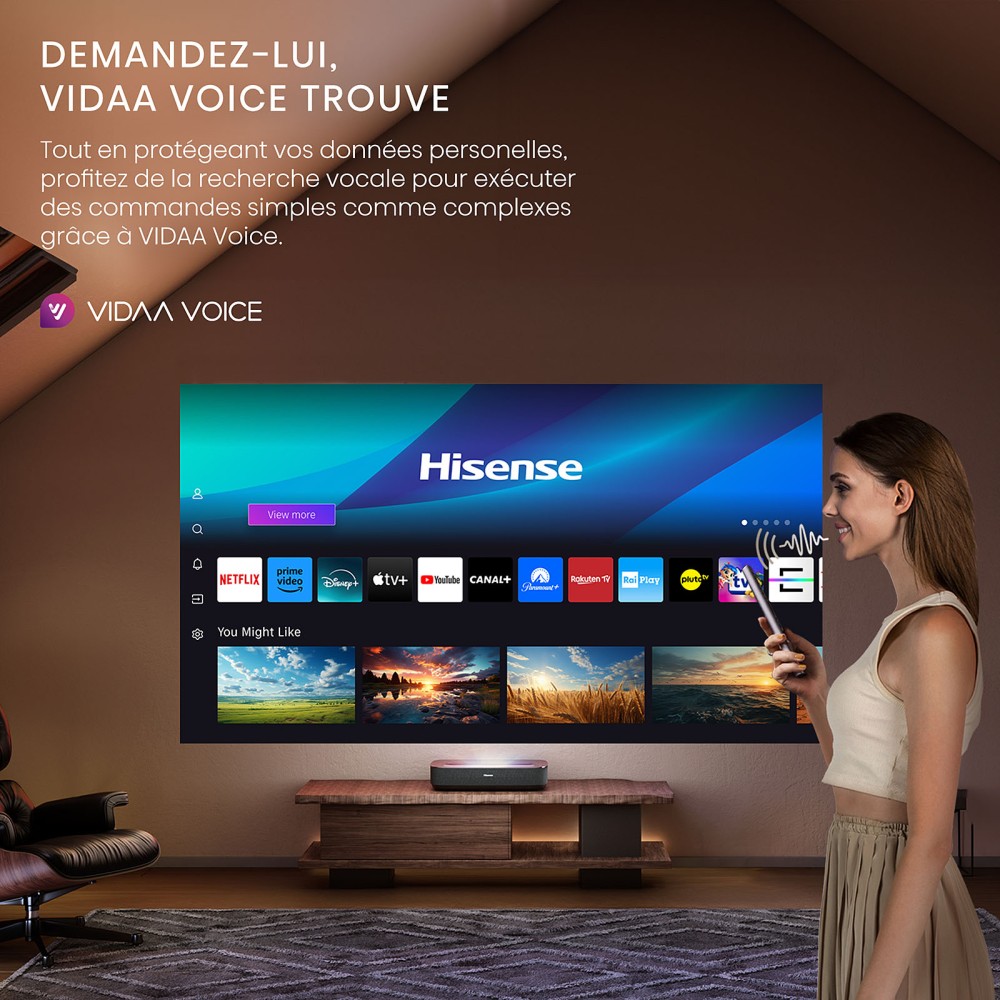
• The The Hisense PX3-Pro model (see illustration below) is the brand's technological flagship. Naturally equipped with TriChroma technology and all the specifications of the PL2 (ideal for setting up a Home Cinema installation), it projects a 4K UHD image with exceptional brightness. It reaches 3,000 lumens while maintaining a remarkable contrast ratio. In addition, its 3D compatibility offers complete immersion in the presence of suitable Blu-Rays. Finally, gamers are not left out, the PX3-Pro was the first ultra short throw projector to obtain Xbox certification for intense video game sessions while guaranteeing low Input Lag and an increased image frequency, up to 240 Hz in the presence of a gaming PC. Finally, its design allows it to blend harmoniously into the most elegant living rooms. Recommended price: 3,000 euros.
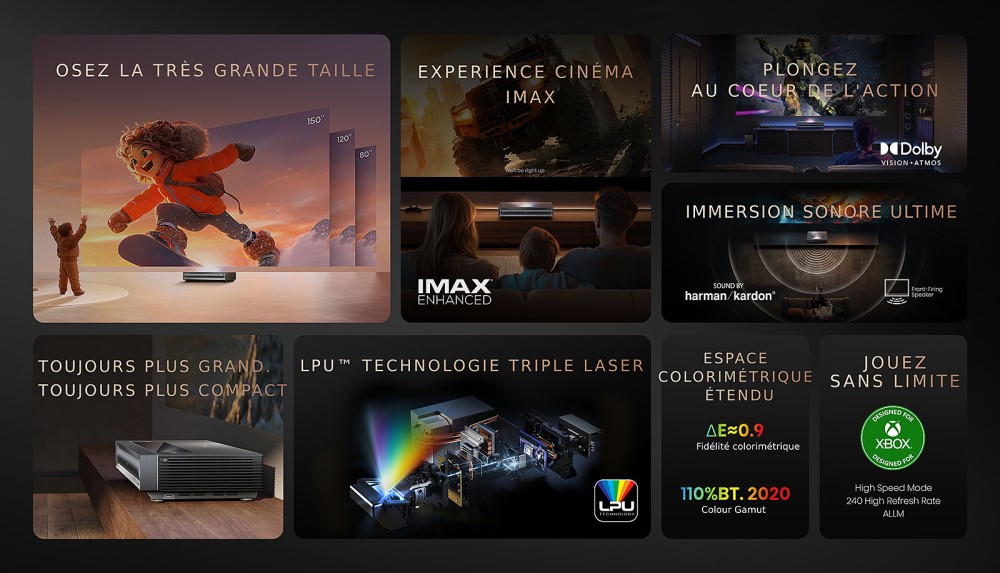
• The Hisense PT1 (see illustrations below), a direct descendant of the PX3-Pro, is the manufacturer's latest product. It incorporates almost all of its specifications and, while its brightness displays 2,500 lumens, it offers the new Auto Screen Fit feature for remarkable ergonomics: the video projector perfectly adjusts the dimensions of the image to those of the screen for easy installation. Enjoying a cinema experience through a beautiful, large image in addition to multi-channel sound has never been easier. Recommended price: 2,500 euros.
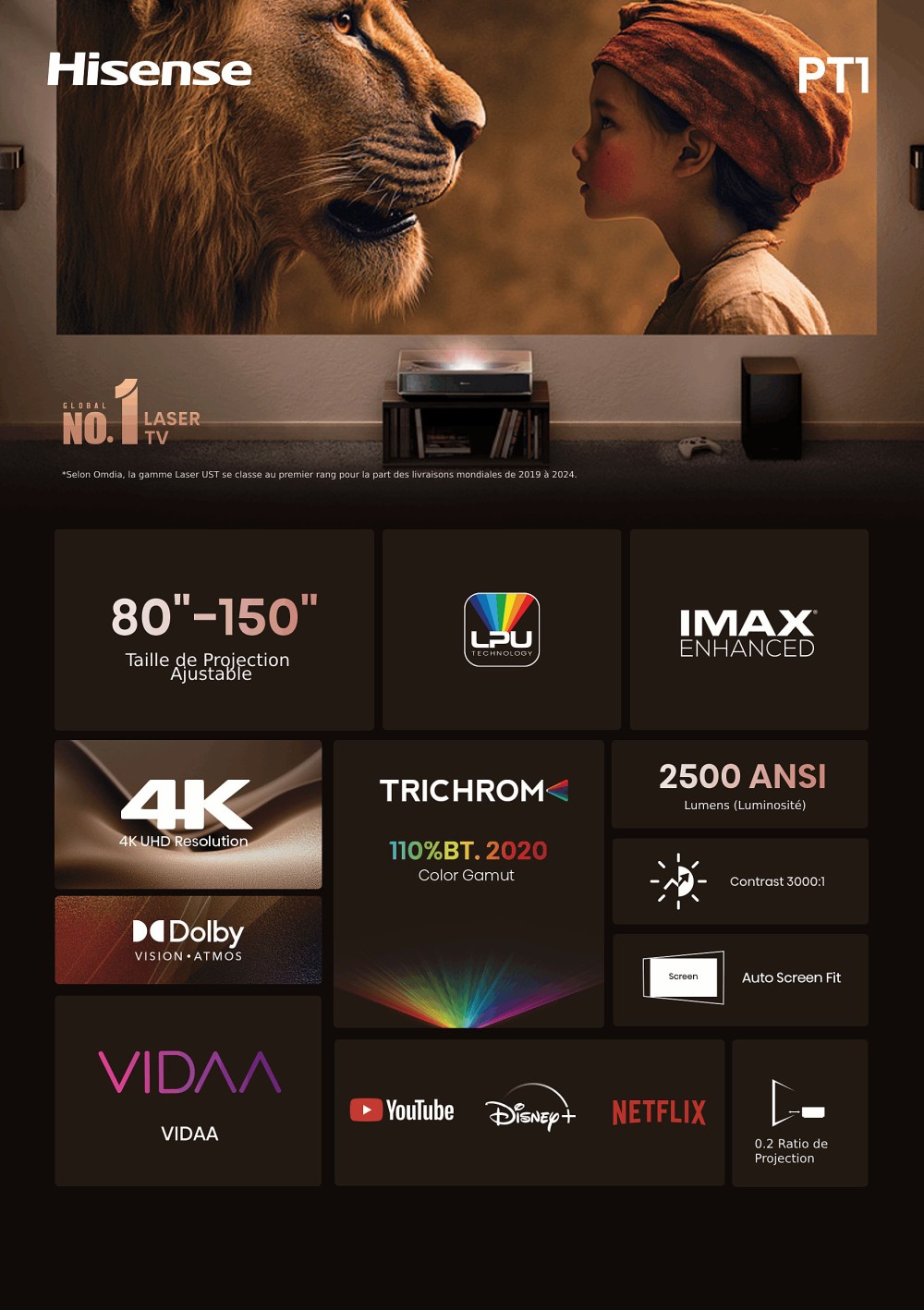
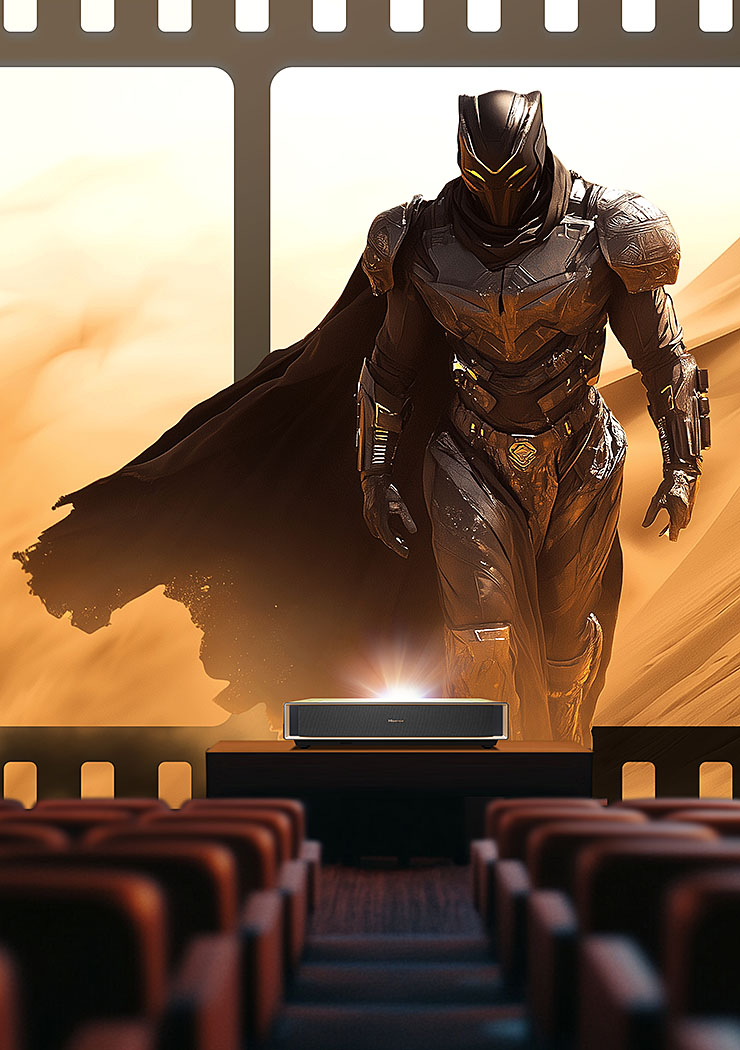
Pack 4.1.2 Hisense HT Saturn, the missing link in the Home Cinema chain££££ If further proof of Hisense's Home Cinema for All strategy was needed, here is the HT Saturn solution. Comprising four speakers and a wireless subwoofer (except for the power supplies, of course), the Hisense HT Saturn can be installed in two or three movements and delivers Dolby Atmos 4.1.2 multichannel spatial and surround sound.
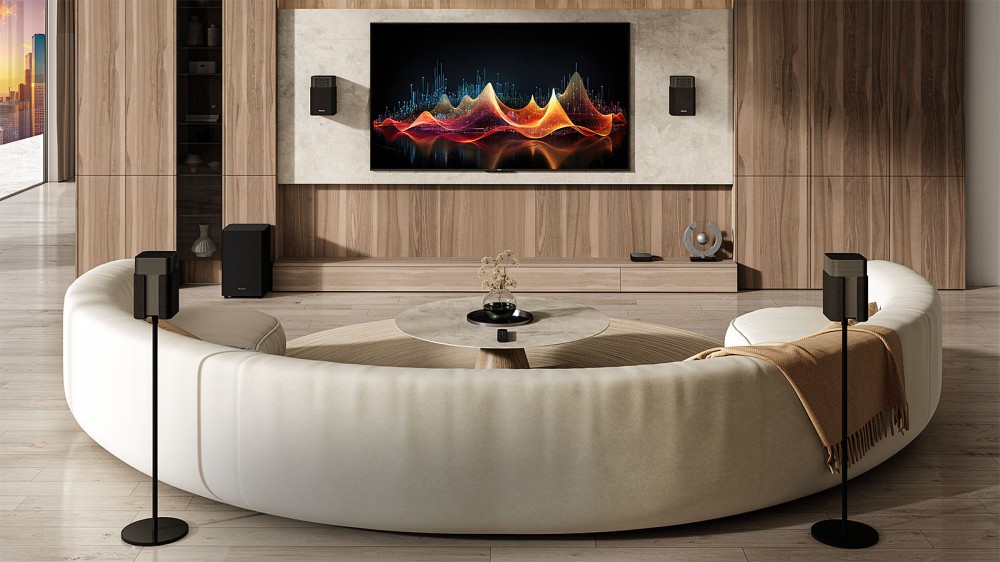
Even more interesting, with the [abc]Firmware[/abc] Vidaa U9 update planned for the end of the year for the Hisense PT1 Laser Cinema, it will be possible to implement the Hi Concerto functionality to mix the projector's sound equipment - dedicated in this case to the central channel - with the HT Saturn to evolve towards an authentic 5.1.2 configuration. Realistic colors, image fluidity, large format... the Hisense promise is therefore kept. The emotions conveyed by Hisense Laser Cinema projectors literally leap from the screen to immerse the viewer, even transporting them to the heart of the action. A proposition that now holds water as an alternative to very large televisions, especially considering the addition of the Hisense HT Saturn pack to consume the content audio-video differently.
 Hisense, pioneer of triple laser with TriChroma technology££££ Since the first generations of laser video projectors, image quality has continued to improve. Hisense quickly stood out by integrating cutting-edge technologies to offer images more vivid colors, increased brightness and precision in details worthy of the best equipment. This is, among other things, the case with the implementation of TriChroma technology. A major development, it has allowed Hisense to differentiate itself from the competition by offering a real leap in terms of image quality, precision and brightness. Exclusive to Hisense, it is based on three separate laser sources, one red, one green and one blue. This is rarely the case with conventional systems, which generally have a single laser source coupled with color filters (see illustration below).
Hisense, pioneer of triple laser with TriChroma technology££££ Since the first generations of laser video projectors, image quality has continued to improve. Hisense quickly stood out by integrating cutting-edge technologies to offer images more vivid colors, increased brightness and precision in details worthy of the best equipment. This is, among other things, the case with the implementation of TriChroma technology. A major development, it has allowed Hisense to differentiate itself from the competition by offering a real leap in terms of image quality, precision and brightness. Exclusive to Hisense, it is based on three separate laser sources, one red, one green and one blue. This is rarely the case with conventional systems, which generally have a single laser source coupled with color filters (see illustration below).  The tri-laser technology chosen by Hisense gives its projectors impressive color reproduction, covering more than 110% of the BT.2020 color space, a level that the latest TVs struggle to achieve. Blacks are deeper, details finer and contrasts enhanced, even in conditions of strong ambient light.
The tri-laser technology chosen by Hisense gives its projectors impressive color reproduction, covering more than 110% of the BT.2020 color space, a level that the latest TVs struggle to achieve. Blacks are deeper, details finer and contrasts enhanced, even in conditions of strong ambient light.  Hisense, pioneer of ultra short throw££££ Furthermore, the appearance of UST (ultra short throw) projectors has transformed their use in Home Cinema configurations. Unlike traditional projectors that must be installed several meters from the screen, Hisense UST models with their throw ratio of approximately 0.2 can be placed just a few centimeters from the wall, or the screen, while projecting an image whose diagonal can reach up to 150" (see illustration below), or more than 3.80 m diagonal.
Hisense, pioneer of ultra short throw££££ Furthermore, the appearance of UST (ultra short throw) projectors has transformed their use in Home Cinema configurations. Unlike traditional projectors that must be installed several meters from the screen, Hisense UST models with their throw ratio of approximately 0.2 can be placed just a few centimeters from the wall, or the screen, while projecting an image whose diagonal can reach up to 150" (see illustration below), or more than 3.80 m diagonal.  If, as with any conventional video projector, a white wall is enough to be able to project an image of impressive dimensions, to fully benefit from the optimal image quality, Hisense (and the editorial staff of AVcesar) recommends the use of a technical screen called ALR, for Ambient Light Rejection. It improves the contrast and clarity of the image, even in a bright room. It eliminates the reflection of ambient light to reflect only that coming from the video projector (see illustration below) and delivers an image quality comparable to that of a television but of a larger size gigantic.
If, as with any conventional video projector, a white wall is enough to be able to project an image of impressive dimensions, to fully benefit from the optimal image quality, Hisense (and the editorial staff of AVcesar) recommends the use of a technical screen called ALR, for Ambient Light Rejection. It improves the contrast and clarity of the image, even in a bright room. It eliminates the reflection of ambient light to reflect only that coming from the video projector (see illustration below) and delivers an image quality comparable to that of a television but of a larger size gigantic.  Hisense Laser Cinema, solutions for every situation££££ Finally, Hisense also aims to offer solutions that precisely meet everyone's expectations and, above all, their budget. Already in his time, that is to say around 350 years before J.-C., Aristotle proclaimed: "Progress is only worthwhile if it is shared by all." If the maxim was taken up by the SNCF in the 90s, Hisense made it its own in 2025 with a range that is based around three models, the PL2, the PX3-Pro and the PT1. • The Hisense PL2 is the [abc]Ultra HD[/abc] [abc]4K[/abc] single laser model in this family of ultra short throw video projectors. It serves as the ideal gateway to discover the world of laser projection. Compatible [abc]HDR10[/abc]/[abc]HDR10+[/abc] and [abc]HDR Dolby Vision[/abc], it is capable of exploiting the contrast dynamics offered by these standards available on 4K [abc]Ultra HD Blu-Ray[/abc] discs, [abc]SVOD[/abc] services (Netfix, Disney+, Amazon Prime, Max, Canal+…, see illustration below). In addition, it has an integrated [abc]Dolby Atmos[/abc] audio system which makes it, in the presence of the Hisense HT Saturn pack (see below), a real complete Home Cinema system (and, what's more, inexpensive). Compact and easy to install, this video projector is aimed at lovers of large image formats but who are keen to spend a reasonable budget on their equipment, less than 2,000 euros.
Hisense Laser Cinema, solutions for every situation££££ Finally, Hisense also aims to offer solutions that precisely meet everyone's expectations and, above all, their budget. Already in his time, that is to say around 350 years before J.-C., Aristotle proclaimed: "Progress is only worthwhile if it is shared by all." If the maxim was taken up by the SNCF in the 90s, Hisense made it its own in 2025 with a range that is based around three models, the PL2, the PX3-Pro and the PT1. • The Hisense PL2 is the [abc]Ultra HD[/abc] [abc]4K[/abc] single laser model in this family of ultra short throw video projectors. It serves as the ideal gateway to discover the world of laser projection. Compatible [abc]HDR10[/abc]/[abc]HDR10+[/abc] and [abc]HDR Dolby Vision[/abc], it is capable of exploiting the contrast dynamics offered by these standards available on 4K [abc]Ultra HD Blu-Ray[/abc] discs, [abc]SVOD[/abc] services (Netfix, Disney+, Amazon Prime, Max, Canal+…, see illustration below). In addition, it has an integrated [abc]Dolby Atmos[/abc] audio system which makes it, in the presence of the Hisense HT Saturn pack (see below), a real complete Home Cinema system (and, what's more, inexpensive). Compact and easy to install, this video projector is aimed at lovers of large image formats but who are keen to spend a reasonable budget on their equipment, less than 2,000 euros.  • The The Hisense PX3-Pro model (see illustration below) is the brand's technological flagship. Naturally equipped with TriChroma technology and all the specifications of the PL2 (ideal for setting up a Home Cinema installation), it projects a 4K UHD image with exceptional brightness. It reaches 3,000 lumens while maintaining a remarkable contrast ratio. In addition, its 3D compatibility offers complete immersion in the presence of suitable Blu-Rays. Finally, gamers are not left out, the PX3-Pro was the first ultra short throw projector to obtain Xbox certification for intense video game sessions while guaranteeing low Input Lag and an increased image frequency, up to 240 Hz in the presence of a gaming PC. Finally, its design allows it to blend harmoniously into the most elegant living rooms. Recommended price: 3,000 euros.
• The The Hisense PX3-Pro model (see illustration below) is the brand's technological flagship. Naturally equipped with TriChroma technology and all the specifications of the PL2 (ideal for setting up a Home Cinema installation), it projects a 4K UHD image with exceptional brightness. It reaches 3,000 lumens while maintaining a remarkable contrast ratio. In addition, its 3D compatibility offers complete immersion in the presence of suitable Blu-Rays. Finally, gamers are not left out, the PX3-Pro was the first ultra short throw projector to obtain Xbox certification for intense video game sessions while guaranteeing low Input Lag and an increased image frequency, up to 240 Hz in the presence of a gaming PC. Finally, its design allows it to blend harmoniously into the most elegant living rooms. Recommended price: 3,000 euros.  • The Hisense PT1 (see illustrations below), a direct descendant of the PX3-Pro, is the manufacturer's latest product. It incorporates almost all of its specifications and, while its brightness displays 2,500 lumens, it offers the new Auto Screen Fit feature for remarkable ergonomics: the video projector perfectly adjusts the dimensions of the image to those of the screen for easy installation. Enjoying a cinema experience through a beautiful, large image in addition to multi-channel sound has never been easier. Recommended price: 2,500 euros.
• The Hisense PT1 (see illustrations below), a direct descendant of the PX3-Pro, is the manufacturer's latest product. It incorporates almost all of its specifications and, while its brightness displays 2,500 lumens, it offers the new Auto Screen Fit feature for remarkable ergonomics: the video projector perfectly adjusts the dimensions of the image to those of the screen for easy installation. Enjoying a cinema experience through a beautiful, large image in addition to multi-channel sound has never been easier. Recommended price: 2,500 euros. 
 Pack 4.1.2 Hisense HT Saturn, the missing link in the Home Cinema chain££££ If further proof of Hisense's Home Cinema for All strategy was needed, here is the HT Saturn solution. Comprising four speakers and a wireless subwoofer (except for the power supplies, of course), the Hisense HT Saturn can be installed in two or three movements and delivers Dolby Atmos 4.1.2 multichannel spatial and surround sound.
Pack 4.1.2 Hisense HT Saturn, the missing link in the Home Cinema chain££££ If further proof of Hisense's Home Cinema for All strategy was needed, here is the HT Saturn solution. Comprising four speakers and a wireless subwoofer (except for the power supplies, of course), the Hisense HT Saturn can be installed in two or three movements and delivers Dolby Atmos 4.1.2 multichannel spatial and surround sound.  Even more interesting, with the [abc]Firmware[/abc] Vidaa U9 update planned for the end of the year for the Hisense PT1 Laser Cinema, it will be possible to implement the Hi Concerto functionality to mix the projector's sound equipment - dedicated in this case to the central channel - with the HT Saturn to evolve towards an authentic 5.1.2 configuration. Realistic colors, image fluidity, large format... the Hisense promise is therefore kept. The emotions conveyed by Hisense Laser Cinema projectors literally leap from the screen to immerse the viewer, even transporting them to the heart of the action. A proposition that now holds water as an alternative to very large televisions, especially considering the addition of the Hisense HT Saturn pack to consume the content audio-video differently.
Even more interesting, with the [abc]Firmware[/abc] Vidaa U9 update planned for the end of the year for the Hisense PT1 Laser Cinema, it will be possible to implement the Hi Concerto functionality to mix the projector's sound equipment - dedicated in this case to the central channel - with the HT Saturn to evolve towards an authentic 5.1.2 configuration. Realistic colors, image fluidity, large format... the Hisense promise is therefore kept. The emotions conveyed by Hisense Laser Cinema projectors literally leap from the screen to immerse the viewer, even transporting them to the heart of the action. A proposition that now holds water as an alternative to very large televisions, especially considering the addition of the Hisense HT Saturn pack to consume the content audio-video differently. 